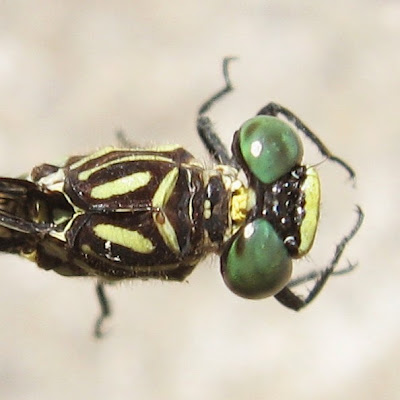Yes, even after seven years of "dragonhunting" there are some species that prove to be my nemesis (or should that be nemeses?) when it comes to separating them in the field, namely, the females of Black-tipped and Lance-tipped Darners.
Male dragonflies are never a problem, they are easily distinguished by their terminalia, such as, for example, this male Black-tipped Darner (Aeshna tuberculifera). The inset shows the claspers and the "black-tip" – the all black S10, although in some individuals this segment may bear tiny blue spots.
The female Black-tipped Darner (Aeshna tuberculifera) is very similar to the male in terms of color and patterning. So far so good ...
Lance-tipped Darner (Aeshna constricta), male ... the inset illustrates the "lance-tipped" cerci, also note the blue spots on the upper surface of S10.
Now let's look at a couple of Lance-tipped Darner (Aeshna constricta) blue form females – as noted in field guides the styli are long and quite visible, but the styli of the Black-tipped Darner are noticeable as well, and lengths can be difficult to judge in the field. Unlike the male's last abdominal segment, the female Lance-tipped Darner's S10 doesn't bear any blue spots, so that doesn't help.
With a length of 71 mm to 78 mm the Black-tipped Darner is theoretically larger than the Lance-tipped Darner, which weighs in at 65 mm to 72 mm. But length is also tough to guesstimate in the great outdoors, and who bothers to cart a ruler around with them on a nature hike?
Lance-tipped Darner female #1
Lance-tipped Darner female #2
The following study of the differences between the females of these two species is based both on the material found in field guides and my own observations. Markings can vary according to the individual insect and by region so I'm not sure how reliable my observations are in the context of the big picture, but they work for me.
Lance-tipped Darner (Aeshna constricta), female:
– The lateral thoracic stripes are relatively narrow and notched.
– The dark lines separating the lateral blue abdominal spots are very straight and quite narrow.
– The blue line on S2 is continuous, and there is generally more blue than dark in this area.
The last two factors conspire to give the Lance-tipped Darner's abdomen a bluer overall aspect than the abdomen of the Black-tipped Darner.

Comparing the female Black-tipped Darner (Aeshna tuberculifera):
– The lateral thoracic stripes are broad and pale, sometimes almost white, and when the dragonfly is perched in a shady place they almost seem to glow.
– The dark lines separating the lateral blue abdominal spots are somewhat irregular, and larger than in the Lance-tipped Darner.
– The blue line on S2 is broken, there is more dark than blue on this part of the dragonfly.
– The face usually bears a thin brown cross-stripe.
Although not common, green and yellow form females occur more frequently among Lance-tipped Darners than Black-tipped Darners. There were a total of about fifty of these striking insects foraging high in the air and perching on the shrubs and this was the only green female encountered.
Note that although the colors are different in the next two examples, the patterning is still consistent with the blue form Lance-tipped Darner females studied above.
Two yellow form females were flying but I was only able to capture one of them.
Before sending this beauty on her way I had to capture an image of those awesome eyes ...
A green form female Lance-tipped Darner in a more natural pose, hiding in plain sight despite its size and eye-catching markings. The complex patterning breaks up the dragonfly's profile and makes it difficult to espy when it's perching among the tangle of background vegetation.








































